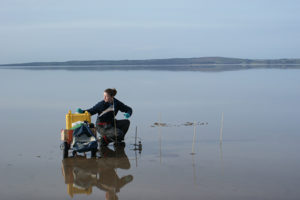On 8 March 2014, the University of St Andrews hosted Science Discovery Day at the School of Physics & Astronomy. Over 400 visitors got to try their hand at innovative science.
Nearly every science discipline was represented at the Science Discovery Day, from theoretical mathematics, the psychology of crime to investigating how fossils are formed.

The Mud Lab gave visitors the opportunity to try their hand at sieving for animals, using microscopes and understanding the stability of mud.
Staff were on hand to explain why salt marshes and mud flats are such an important habitat for providing food for so many animals and plants and their vital role in flood defence (by stabilizing mud).
Visitors had the chance to sieve mud collected from the Eden Estuary just outside St Andrews for animals that make mudflats their home and gain an insight into the variety of life that inhabits these vast ’empty’ spaces. Everyone was keen to get a closer look at these sometimes tiny creatures and to learn more about the vital role they play in the food web. Microscopes allowed visitors to get a closer look and Mud Lab staff explained the amazing life history of the animals they were looking at.

It’s essential to not only understand what lives in mudflats, but how they stabilize the mud itself. Visitors were able to use a piece of kit that allows researchers to do just this; a Cohesion Strength Meter (CSM). A CSM measures how much pressure it takes to erode the surface of the mud, this measurement combined with an understanding of what lives in the mud provides an insight into how stable a mudflat is. This is essential information if we are to understand the role of mudflats as flood defences.
Click on picture list below to see the slideshow.
